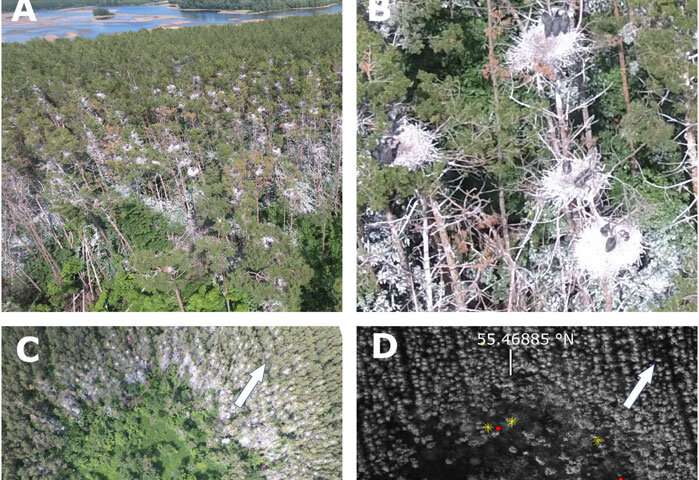Scientists find pine forest endangered by grey heron

KFU and Saint-Petersburg Electrotechnical University researched pines near Panovo village in Tatarstan; the paper appeared in Frontiers in Environmental Science.
Associate Professor (Department of General Ecology) Denis Tishin comments, "We study colonies of grey heron. It's a rather widespread bird in Tatarstan. At a logline near Panovo village we found about 300 nests. The logline is about 100 meters in diameter."
Dendrochronological tests showed that the heron colony here was formed in 2006—2007, whereas the pine forest where it emerged dates back to 1983.
Tishin continues, "Since herons inhabited the forest, it has already lost over a thousand trees. They continue dying right now. The forest will probably completely disappear in about 20 years. The pines covered by nests are under both mechanical and chemical stress—the latter from large masses of feces. Obviously, feces are also highly present in local soil." As the researchers posits, older trees might have endured such an aggressive influence.
The birds' dung and feathers change the soil's microbial and chemical composition. For instance, the logline soil contains high ratios of phosphorus and nitrogen. The logline's pH level is lower than normal. In particular, nitrogen favors the growth of nettle. The soil also has a lack of manganese and cobalt. This can negatively affect plant growth and microbial richness.
Chair of the Department of Genetics Airat Kayumov says about the local microbiota, "Soil microbiota is the most important ecosystem parameter, which, on the one hand, strongly influences the flora and fauna of the biotope and, on the other hand, is sensitive to external influences, so it is a marker of biological system stability. We found that the relative content of some of the most important acid-resistant bacterial groups differed significantly between the soil plot under the trees where the birds lived and the control plot. This indicates that the soil properties of these plots are different, so it is not surprising that plants grow differently there as well."
Researchers at St. Petersburg State Electrotechnical University used the data to build a comprehensive mathematical model in the form of a directed graph reflecting the assumed causal relationships between changes in various biological, geochemical and hydrometeorological factors and ecosystem well-being indicators, represented by vegetative activity indices determined using multispectral remote sensing data, and the dynamics of annual tree growth.
Such models are often referred to as predictive models because they can be used to simulate scenarios of various changes in similar ecosystems, which may occur both as a result of natural factors, including climatic changes, and as a result of economic activities, such as the intensification of agricultural activities associated with the active use of organic fertilizers. A key advantage of this approach is the possibility of predicting various scenarios without any experimental intervention in the existing ecosystems with model training based on the data generated from similar natural experiments.
Next year, the group plans to study three colonies of great grey heron, which have taken a fancy to forests in the Mamadysh and Agryz districts of the Republic of Tatarstan.
More information:
The impact of Grey Heron (Ardea cinerea L.) colony on soil biogeochemistry and vegetation: a natural long-term in situ experiment in a planted pine forest
www.frontiersin.org/articles/1 … vs.2023.1197657/full%C2%A0
Provided by Kazan Federal University